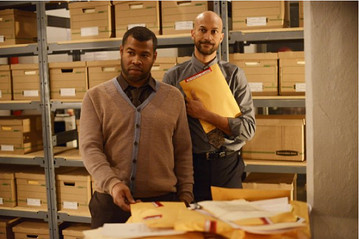 In philosophy there is a well-known problem known as the Sorites (σωρίτης) Paradox, or the “Paradox of the Heap.” I was first made aware of the paradox several months ago while watching an excellent episode of the hit FX mini-series, Fargo. The episode, titled “The Heap,” features a scene with two FBI agents (played by Keegan-Michael Key and Jordan Peele) in which the concept of the Sorites Paradox is reconfigured as a file room: the two agents, stuck in a large room full of file cabinets and manila folders, discuss the point at which the file room would no longer be a file room if one were to remove the files one at a time.
In philosophy there is a well-known problem known as the Sorites (σωρίτης) Paradox, or the “Paradox of the Heap.” I was first made aware of the paradox several months ago while watching an excellent episode of the hit FX mini-series, Fargo. The episode, titled “The Heap,” features a scene with two FBI agents (played by Keegan-Michael Key and Jordan Peele) in which the concept of the Sorites Paradox is reconfigured as a file room: the two agents, stuck in a large room full of file cabinets and manila folders, discuss the point at which the file room would no longer be a file room if one were to remove the files one at a time.
Ιmagine a large heap of some kind of material—grains of sand, wood chips, coins, McDonald’s French fries. Take one of these constituent pieces away, and the heap remains a heap. Take two away, and the heap is still there. But continue removing grains of sand or wood chips or coins or McDonald’s French fries, and at some point the heap will cease to be recognizable as a heap. Likewise, if one were to gather only one grain of sand, or two, or three, etc., it is doubtful these few collected grains of sand would constitute what we would call a heap. The question raised by the Sorites Paradox is essentially one of degrees: At what point is a heap no longer a heap, or, conversely, at what point does a collection of individual, constituent parts become recognizable as a heap?
It recently occurred to me that the Sorites Paradox is a helpful illustration to begin thinking about the problem of the individual books that constitute the biblical canon. I am not as interested in the question of how the canon as we know it was collected and organized into the critical edition library of texts used in most churches and religious studies programs today; to me, at least, the far more interesting question is how readers come to recognize an individual biblical book as a particular iteration of that book. For example, there are currently twelve extant manuscripts of the Gospel of Luke that pre-date the fifth century. Most of these are papyri fragments. And according to the Nestle-Aland 28th critical edition of the Greek New Testament, among these twelve manuscripts there are dozens of textual variations. With no autographs (i.e. “original” manuscripts) to provide a baseline, how do we determine which Luke is the “real” gospel? Moreover, at what point does a manuscript become so modified that it is no longer recognized as the gospel in question? The Gospel of Luke featured in a number of vellum manuscripts from the 11th – 15th centuries, for example, includes the so-called Pericope Adulterae most commonly associated with John 7:53 – 8:11. When this passage is transplanted into the Gospel of Luke, does it then become, for all intents and purposes, “Lukan”? Or does the presence of a passage typically associated with the Gospel of John change the nature of the Gospel of Luke entirely? Like the Paradox of the Heap, how many textual variants does it take before a biblical book ceases to be a recognizable biblical book, with all the ecclesiastical and academic authority that comes with being part of the canon?
If a musician changes a few notes of a well-known piece of music, listeners might understand the variation as an embellishment, but would most likely still be able to identify it with the original composition. The Polyphonic Spree’s cello and brass-horn-laden cover of Neil Young’s “Heart of Gold,” though a vast departure from Young’s stripped-bare acoustic guitar and harmonica tune, is still easily recognizable by listeners as Young’s original composition. Yet when we are dealing with texts—especially collections of ancient texts with no extant originals—the criteria for deciding what constitutes a book appear to be different than those for recognizing a piece of popular music. So at what point does a text vary from another copy so much that it ceases to be recognizable as the same text?